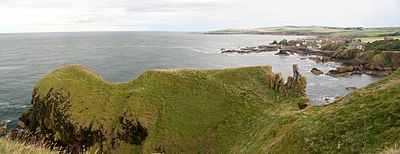St Abbs: Difference between revisions
No edit summary |
|||
| (3 intermediate revisions by 2 users not shown) | |||
| Line 1: | Line 1: | ||
{{county | {{Infobox town | ||
|name=St Abbs | |||
|county=Berwickshire | |||
|picture=St abbs borders scotland.jpg | |||
|picture caption=St Abbs Harbour as seen from the coastal path | |||
|os grid ref=NT919672 | |||
|latitude=55.898643 | |||
|longitude=-2.129701 | |||
|postcode=TD14 | |||
|LG district=Scottish Borders | |||
|constituency=Berwickshire, Roxburgh and Selkirk | |||
}} | |||
'''St Abbs''' historically known as '''Coldingham Shore''', is a small fishing village in [[Berwickshire]]. | '''St Abbs''' historically known as '''Coldingham Shore''', is a small fishing village in [[Berwickshire]]. | ||
The | The name was changed in the 1890s, derived from St Abb's Head, a rocky promontory located to the north of the village, itself named after St Aebbe. | ||
==History== | ==History== | ||
Prior to any buildings the fishermen who worked their boats from the beach resided at Fisher's Brae in [[Coldingham]]. These fishermen had to carry their fishing gear the one and a half miles down a path. The path is now known as the Creel Path, Creel is the local name for a Lobster pot. | |||
The first building in St | The first building in St Abbs was constructed about the middle of the 18th century followed later by a row of five cottages. This first row of houses where constructed in a traditional Scottish style with a central fire and a wide chimney. The walls were constructed of "Clat and Clay" a framework of wood interlaced with straw and daubed over with moist clay. | ||
By 1832 it is recorded that the inhabitants of the Shore comprised sixteen families, who with twenty others residing in [[Coldingham]], obtained their livelihood by fishing. In addition to these, thirty people proceeded annually to the North for the Herring fishing, which gave employment for fourteen boats from the village. | By 1832 it is recorded that the inhabitants of the Shore comprised sixteen families, who with twenty others residing in [[Coldingham]], obtained their livelihood by fishing. In addition to these, thirty people proceeded annually to the North for the Herring fishing, which gave employment for fourteen boats from the village. | ||
| Line 29: | Line 39: | ||
[[File:St Abbs Visitor Centre.JPG|thumb|St Abbs Visitor Centre]] | [[File:St Abbs Visitor Centre.JPG|thumb|St Abbs Visitor Centre]] | ||
March 2011 saw the opening of the latest addition to the many attractions of St Abbs in the form of the new [http://www.stabbsvisitorcentre.co.uk St Abbs Visitor Centre]. A beautiful, contemporary facility, it is located in the old village hall, perched precariously on a cliff edge. Built as a resource for both visitors and locals, the Centre offers free admission, interactive exhibits, library area, web access, stunning photographs and historical artefacts. It's an ideal starting point to a visit to St Abbs, giving information on the history of the village, the geology and also the local flora and fauna visitors are likely to encounter. The position of the building offers a stunning 180 degree view from St Abbs Head all the way to the harbour and beyond. The [http://www.stabbsvisitorcentre.co.uk St Abbs Visitor Centre] is an independent Scottish charity. | March 2011 saw the opening of the latest addition to the many attractions of St Abbs in the form of the new [http://www.stabbsvisitorcentre.co.uk St Abbs Visitor Centre]. A beautiful, contemporary facility, it is located in the old village hall, perched precariously on a cliff edge. Built as a resource for both visitors and locals, the Centre offers free admission, interactive exhibits, library area, web access, stunning photographs and historical artefacts. It's an ideal starting point to a visit to St Abbs, giving information on the history of the village, the geology and also the local flora and fauna visitors are likely to encounter. The position of the building offers a stunning 180 degree view from St Abbs Head all the way to the harbour and beyond. The [http://www.stabbsvisitorcentre.co.uk St Abbs Visitor Centre] is an independent Scottish charity. | ||
==On film== | |||
[[File:St Abbs Twinned with New Asgard.jpg|left|thumb|220px|St Abbs twinning sign]] | |||
St Abbs appears in the 2019 superhero film ''Avengers: Endgame'', in which it features as the location of New Asgard, a town settled by the surviving Asgardians and led by Thor. | |||
Following the film’s release, the village saw a surge in tourism and popularity.<ref>[https://stv.tv/news/entertainment/1437338-scots-fishing-village-s-starring-role-in-avengers-endgame/ Scots Fishing Village's Starring Role in Avengers Endgame]: STV News</ref> The village signs now claim that the village is 'twinned with New Asgard'. | |||
{{clear}} | |||
==Outside links== | |||
*[http://www.stabbs.org/ St Abbs Community] | |||
*[http://www.scotborders.gov.uk/pdf/9635.pdf Local Plan for St Abbs] | |||
*[http://www.stabbsvisitorcentre.co.uk/ The St Abbs Visitor Centre] | |||
==References== | ==References== | ||
{{Reflist|2}} | {{Reflist|2}} | ||
[[ | [[File:St Abbs pan.jpg|thumb|400px|center|St Abbs from the north.]] | ||
[[Category:Towns and villages in Berwickshire]] | [[Category:Towns and villages in Berwickshire]] | ||
{{Port}} | |||
Latest revision as of 20:29, 16 August 2020
| St Abbs | |
| Berwickshire | |
|---|---|
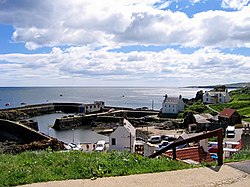 St Abbs Harbour as seen from the coastal path | |
| Location | |
| Grid reference: | NT919672 |
| Location: | 55°53’55"N, 2°7’47"W |
| Data | |
| Postcode: | TD14 |
| Local Government | |
| Council: | Scottish Borders |
| Parliamentary constituency: |
Berwickshire, Roxburgh and Selkirk |
St Abbs historically known as Coldingham Shore, is a small fishing village in Berwickshire.
The name was changed in the 1890s, derived from St Abb's Head, a rocky promontory located to the north of the village, itself named after St Aebbe.
History
Prior to any buildings the fishermen who worked their boats from the beach resided at Fisher's Brae in Coldingham. These fishermen had to carry their fishing gear the one and a half miles down a path. The path is now known as the Creel Path, Creel is the local name for a Lobster pot.
The first building in St Abbs was constructed about the middle of the 18th century followed later by a row of five cottages. This first row of houses where constructed in a traditional Scottish style with a central fire and a wide chimney. The walls were constructed of "Clat and Clay" a framework of wood interlaced with straw and daubed over with moist clay.
By 1832 it is recorded that the inhabitants of the Shore comprised sixteen families, who with twenty others residing in Coldingham, obtained their livelihood by fishing. In addition to these, thirty people proceeded annually to the North for the Herring fishing, which gave employment for fourteen boats from the village.
The village was renamed at the end of the 19th century by the then Laird Mr Andrew Usher, to its present title St Abbs.
In November 1907 the Member of Parliament for Berwickshire, Mr H J Tennant, announced that the Royal National Lifeboat Society had agreed to supply St Abbs with a lifeboat, and that the Board of Trade had also agreed to place life-saving apparatus at St Abbs as soon as possible.[1]
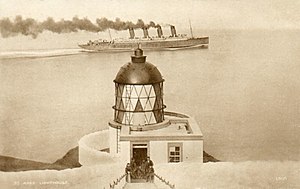
St Abbs was the main subject of the book, Ebb Tide: Adrift on the Waves of Memory With the Fisher Folk of Berwickshire, by Will Wilson.
Diving
St Abbs is a popular site for Scuba Divers. The sea around the village is unusually clear, in contrast to the more silt-laden coastal waters further to the north or south. These clear waters and the spectacular underwater scenery resulted in Britain's first Voluntary Marine Reserve being established at St Abbs. The Marine Reserve was established on 18 August 1984 by David Bellamy.
Shore diving to a depth of about 50 ft is possible from the rocks on the outside of the harbour wall. It is common for trainees to do initial sea dives here.
The double archway at "Cathedral Rock" is just 150 ft from the shore.[2][3] Several small, nearby rocky islands, such as "Big Green Carr", "Broad Craig" and "Little Carr" are near to the harbour and easily can be circumnavigated underwater.[4]
The St Abbs Visitor Centre
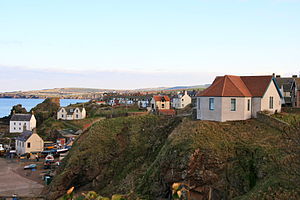
March 2011 saw the opening of the latest addition to the many attractions of St Abbs in the form of the new St Abbs Visitor Centre. A beautiful, contemporary facility, it is located in the old village hall, perched precariously on a cliff edge. Built as a resource for both visitors and locals, the Centre offers free admission, interactive exhibits, library area, web access, stunning photographs and historical artefacts. It's an ideal starting point to a visit to St Abbs, giving information on the history of the village, the geology and also the local flora and fauna visitors are likely to encounter. The position of the building offers a stunning 180 degree view from St Abbs Head all the way to the harbour and beyond. The St Abbs Visitor Centre is an independent Scottish charity.
On film
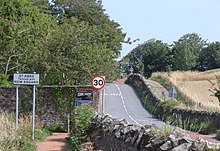
St Abbs appears in the 2019 superhero film Avengers: Endgame, in which it features as the location of New Asgard, a town settled by the surviving Asgardians and led by Thor.
Following the film’s release, the village saw a surge in tourism and popularity.[5] The village signs now claim that the village is 'twinned with New Asgard'.
Outside links
References
- ↑ The Berwickshire News 29 November 2007, "Looking Back", p.13
- ↑ http://www.stabbs.org/shorediving.html
- ↑ http://www.ukdiving.co.uk/places/coastal/articles/st_abbs.htm
- ↑ http://www.dcordes.freeuk.com/abbs.htm
- ↑ Scots Fishing Village's Starring Role in Avengers Endgame: STV News
